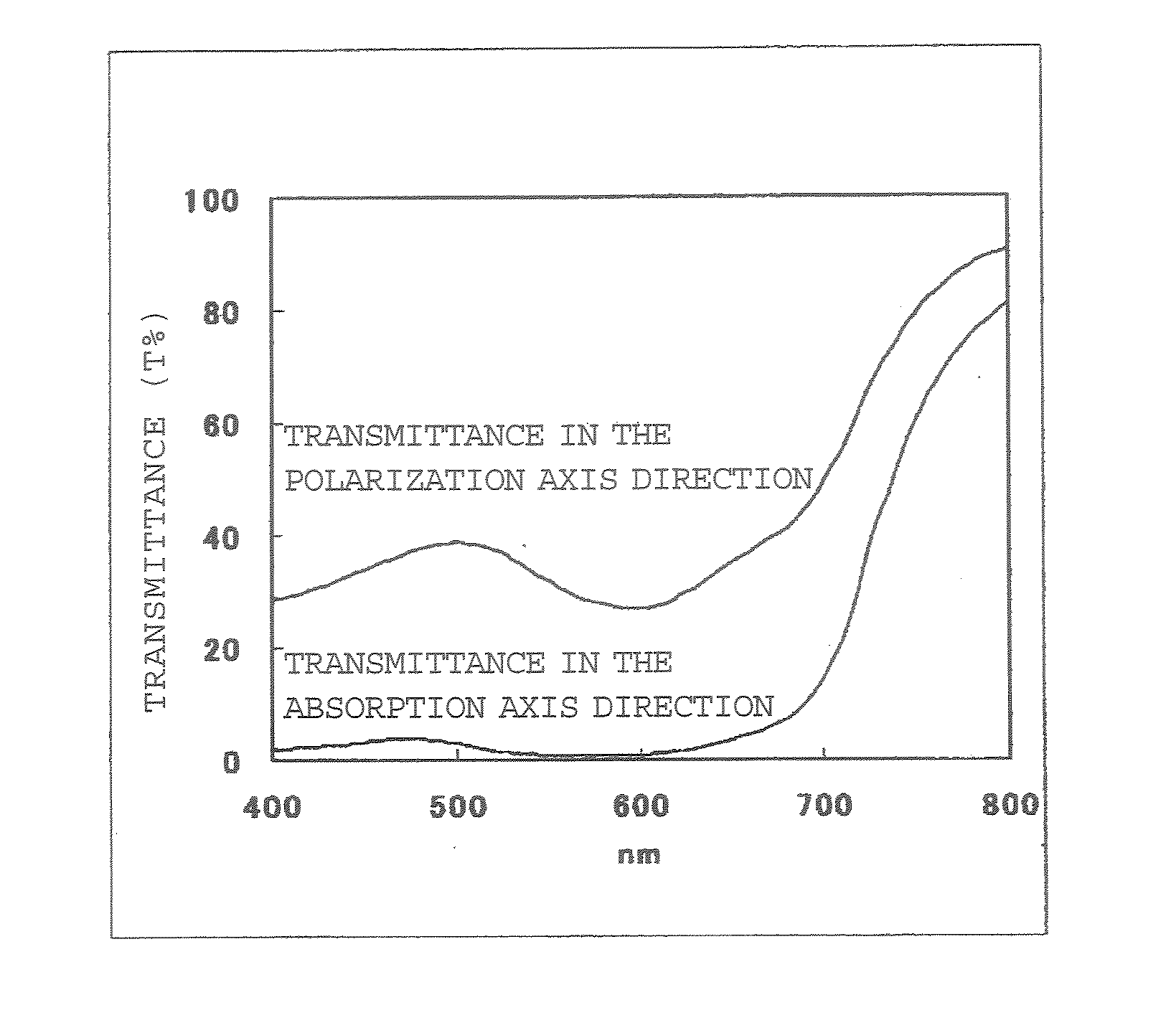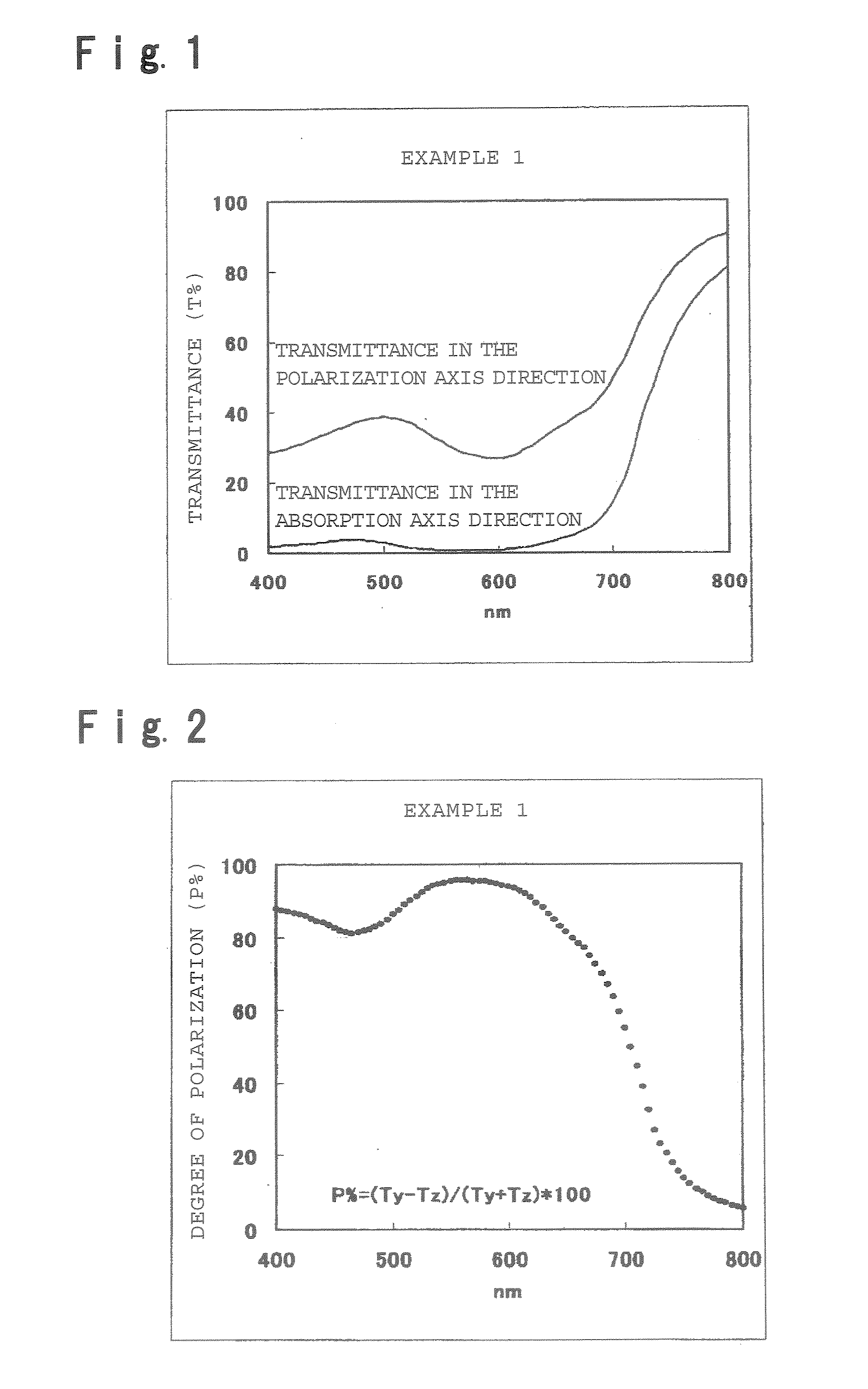Trisazo Dye, Composition Containing the Same for Anisotropic Dye Film, Anisotropic Dye Film, and Polarizing Element
a trisazo dye and anisotropic dye technology, applied in monoazo dyes, organic dyes, polarizing elements, etc., can solve the problems of inability to achieve ideal achromatic color polarizing plates for the entire visible spectral region, etc., to achieve low chromaticness, high degree of molecular orientation degree degree of polar
- Summary
- Abstract
- Description
- Claims
- Application Information
AI Technical Summary
Benefits of technology
Problems solved by technology
Method used
Image
Examples
example 1
[0111] 10 parts of sodium salt of the above dye No. (1-1) was added to 90 parts of water, stirred and dissolved, followed by filtration to obtain a dye aqueous solution (composition for an anisotropic dye film).
[0112] On the other hand, as a substrate, a glass substrate having a polyimide oriented film formed thereon by silk printing (75 mm×25 mm, thickness 1.1 mm, the polyimide oriented film with a polyimide film thickness of about 800 Å preliminarily subjected to rubbing treatment with cotton cloth) was prepared. The above dye aqueous solution was applied on the substrate by a spin coater (SC-200 manufactured by Oshigane) 2,500 rpm for 15 seconds) and air dried to obtain an anisotropic dye film in which the dye was oriented in the rubbing direction.
[0113] The transmittance (Tz) of the obtained anisotropic dye film for a polarized light having a plane of vibration in the absorption axis direction in the plane of the dye film and the transmittance (Ty) for a polarized light having...
example 2
[0114] 10 parts of lithium salt of the above dye No. (1-15) and 0.2 part of a nonionic surfactant (Emulgen 109P, manufactured by Kao Corporation) were added to 90 parts of water, stirred and dissolved, followed by filtration to obtain a dye aqueous solution (composition for an anisotropic dye film). The composition was applied to the same substrate subjected to orientation treatment as one used in Example 1 with a bar coater No. 3 (manufactured by TESTER SANGYO CO., LTD.) and air dried to obtain an anisotropic dye film. The transmittance (Tz) of the obtained anisotropic dye film for a polarized light having a plane of vibration in the absorption axis direction and the transmittance (Ty) for a polarized light having a plane of vibration in the polarization axis direction in the plane of the dye film were measured and shown in FIG. 3. Further, the degree of polarization (P %) at each wavelength is shown in FIG. 4. The dye film of the present invention had a substantially constant degr...
example 3
[0115] The dye aqueous solution prepared in Example 1 was injected into a quartz cuvette having an optical path length of 0.01 mm and the transmittance in the visible wavelength region was measured by a spectrophotometer (U-3500, manufactured by Hitachi Ltd.,) and then the transmission chromaticity under standard illuminant D65 was measured by methods stipulated in JIS Z8701-1995 (CIE No. 15.2) and JIS Z8722-1994. Further, the dye aqueous solution was diluted with distilled water so that the dye concentrations (weight ratio) were 1,000 ppm and 10 ppm, and the aqueous solution at a concentration of 1,000 ppm and the aqueous solution at a concentration of 10 ppm were injected into quartz cuvettes having optical path lengths of 0.1 mm and 10 mm, respectively, to determine the transmission chromaticity by the same methods. The trail of the change in chromaticity at the respective concentrations is shown in the C.I.E. chromaticity diagram in FIG. 5. With respect to the dye of the present...
PUM
 Login to View More
Login to View More Abstract
Description
Claims
Application Information
 Login to View More
Login to View More - R&D
- Intellectual Property
- Life Sciences
- Materials
- Tech Scout
- Unparalleled Data Quality
- Higher Quality Content
- 60% Fewer Hallucinations
Browse by: Latest US Patents, China's latest patents, Technical Efficacy Thesaurus, Application Domain, Technology Topic, Popular Technical Reports.
© 2025 PatSnap. All rights reserved.Legal|Privacy policy|Modern Slavery Act Transparency Statement|Sitemap|About US| Contact US: help@patsnap.com



